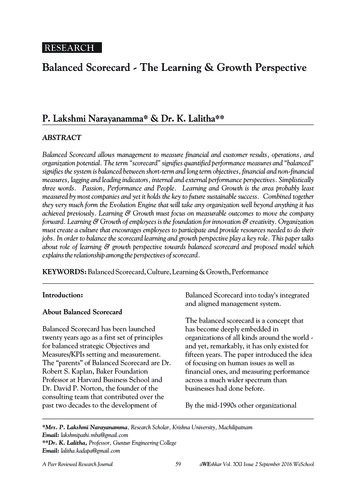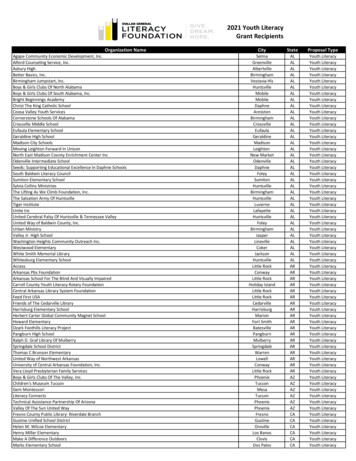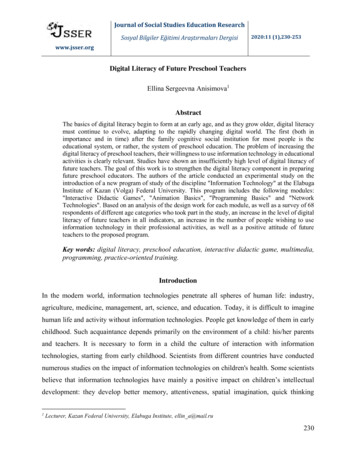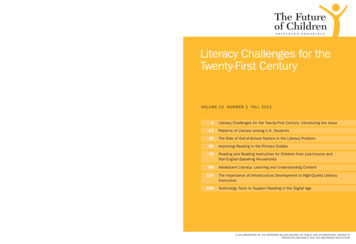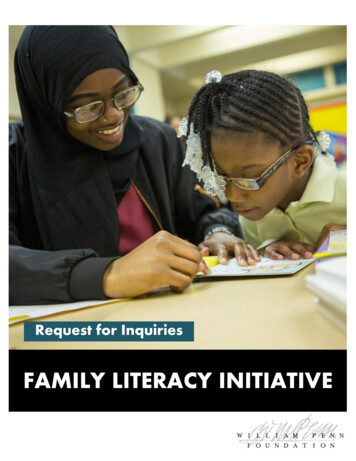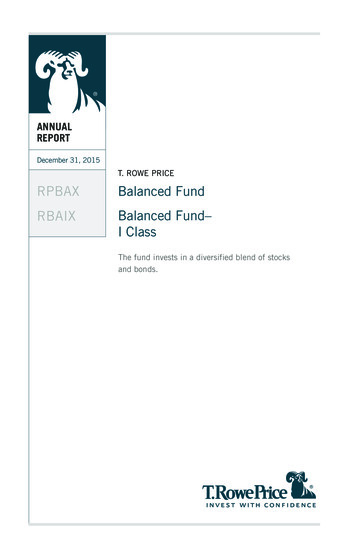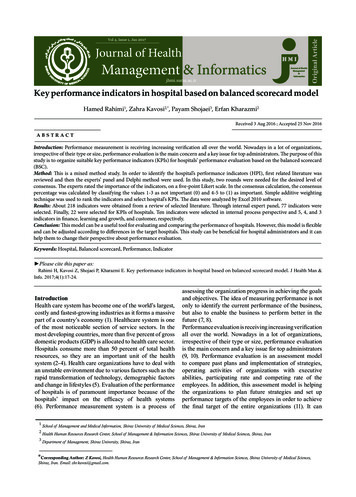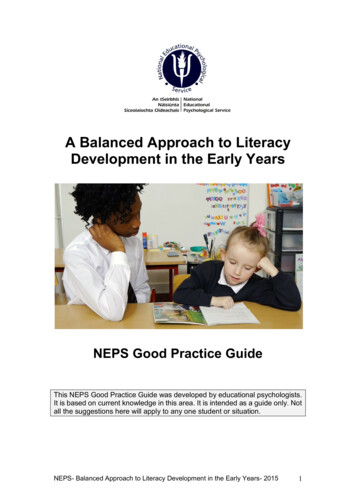
Transcription
A Balanced Approach to LiteracyDevelopment in the Early YearsNEPS Good Practice GuideThis NEPS Good Practice Guide was developed by educational psychologists.It is based on current knowledge in this area. It is intended as a guide only. Notall the suggestions here will apply to any one student or situation.NEPS- Balanced Approach to Literacy Development in the Early Years- 20151
AcknowledgementsWe would like to offer a special thanks to the following school communities,the parents, children and teachers who contributed so much to this resource.Presentation Primary School, Sexton Street, Limerick, particularly KayeTwomey and Máire O’Sullivan.St. Michaels Infant School, Sexton Street, Limerick, especially Maria Dervanand Emma Keane.St Tola’s National School, Tullyglass, Shannon, Co. Clare, with a specialmention for Karen Riordan.Bansha National School, Bansha, Co. Tipperary, with thanks to ClíodhanBreen.Glór na Mara National School, Convent Hill, Tramore, Co. Waterford, withthanks to Aoife O’Riordan.Thanks also to Siobhan O’Donoghue, Reading Recovery Specialist withthe PDST, Limerick Education Centre, for her invaluable contributions.This resource was developed by the Literacy Working Group, NationalEducational Psychological ServiceMary Nugent (chair)Lucy GannonYvonne MullanDiarmuid O’RourkeFinally, particular thanks to Aoife Olsthoorn, who shot the video footage,contributed to editing and managed many aspects of this project as part of aJobsbridge placement.NEPS- Balanced Approach to Literacy Development in the Early Years- 20152
Section 1 Introduction1.1 Who is this Guide for?This Good Practice Guide is intended for use mainly by teachers working withchildren in Junior and Senior Infants and may also be relevant to teachers ofFirst Class children. It has been developed by psychologists from NEPS andis intended to support the National Literacy and Numeracy Strategy, 2011. Theaim of the pack is to help teachers plan and deliver a balanced approach toliteracy in the early years, by sharing information about evidence-basedapproaches and best practices. The research literature is supplemented byshort video clips, filmed in Irish schools, which demonstrate good practice inaction.It is also intended to support the work of principals, deputy principals andliteracy co-ordinators in primary schools. The National Strategy outlinesobjectives in relation to school self-evaluation, effective approaches to literacyteaching and the use of assessment in supporting literacy. It is hoped that thisresource pack will inform and support that work.Click here to see Mary Nugent, (EducationalPsychologist, NEPS) talking about this resource.NEPS- Balanced Approach to Literacy Development in the Early Years- 20153
The guide is divided into the following sections:Section 1- IntroductionSection 2- The Need for a Balanced ApproachPreventing reading failure, evidence-based practice, introducing the balancedapproach, framework of the balanced approach, time for readingSection 3- Essentials for ReadingAccess to books, oral language experiences, reading at home, motivationSection 4- Learning to Recognise WordsPhonological awareness, phonics (alphabetic knowledge), sight words, wordreading strategiesSection 5- Meaningful ReadingVocabulary, comprehension, fluencySection 6- Written CommunicationHandwriting, spelling and meaningful writingSection 7- Assessment for Teaching and LearningThe assessment plan, assessment for learning, assessment of learningSection 8- Rich Reading ExperiencesThe gradual release of responsibility, interactive read aloud, shared reading,guided reading, oral reading from just-right texts, independent readingSection 9- Teacher DevelopmentQuality of teaching, professional development for teachers1.2 What sources of evidence were used?The synthesis of research findings reported in this guide, is drawn from a rangeof publications and seminal texts, with a focus on material published in the last15 years. The key texts used are listed in the References section.NEPS- Balanced Approach to Literacy Development in the Early Years- 20154
Section 2- The Need for a Balanced ApproachIt is possible today to help our youngest readers learn to read more successfullythan ever before, particularly by taking advantage of what many years ofconclusive evidence from research assures us about the effectiveness of abalanced approach to reading instruction.Cowen, 2005, xiii2.1 Preventing Reading FailureIn Ireland, approximately 20% of children in first and second class are offeredlearning support in literacy, as they are considered to be under-achieving. Datafrom 2013 indicated that 11% of children attending disadvantaged schools inIreland were reading at or below the 10th percentile in second class (and anadditional 8% were not tested, due to absence or exemption from testing) andthis rose to 20% by sixth class (Weir and Denner, 2013).However, there is also evidence that schools which provide quality instructionin the early years find that the vast majority of their pupils can achieve at ageappropriate levels. Look at the data below, taken from end of year testing in aDEIS school in 2012.Table 1. Mean 1st class scores, Woodcock Johnson Test of AchievementArea TestedPercentileStandard ScoreWord Reading82nd114Reading comprehension64th105Reading fluency75th110Spelling55th102This data shows us that quality teaching can bring about above averageoutcomes for children, including children in disadvantaged communities andchildren for whom English is not their first language.NEPS- Balanced Approach to Literacy Development in the Early Years- 20155
There is a view that dyslexia is often misdiagnosed as an explanation forreading failure. Vellutino, Snowling and Scanlon, 2004, in a comprehensivereview of dyslexia research, concluded that, ‘recent intervention studies haveclearly demonstrated that reading difficulties in most beginning readers are notinvariably caused by basic cognitive deficits or biological origin’, and therefore‘current estimates of the incidence of true reading disabilities are greatlyinflated’. They suggest that some struggling readers are ‘instructionalcasualties’.This view is supported by Pressley, 2006, who points out thatbiological dyslexia is rare compared with reading failure due to inappropriateinstruction. He suggests that for many poor readers, their problem may be thatthey never received systematic, intensive instruction in decoding or have had itin a watered-down fashion.Another explanation for reading failure, is that some readers have English as asecond language. However, ‘the vast majority of children and adults with poorliteracy skills were born and raised in the country they live in and speak itslanguage of instruction as their mother tongue.’ (EU Final Report, 2012).Every child can, in principle, learn to read and write.EU Final Report, 20122.2 Evidence Based PracticeTeachers need to have a comprehensive knowledge of literacy development,informed by evidence-based best practice (Morrow and Gambrell, 2011). Thispractice is informed by research and the methods used to teach literacy shouldbe rigorously tested in real world situations. There is converging evidence frommultiple sources about effective teaching in the early years. The following tenevidence based best practices for comprehensive literacy instruction are takenfrom Gambrell, Malloy and Mazzoni, 2011;NEPS- Balanced Approach to Literacy Development in the Early Years- 20156
1. Create a classroom culture that fosters literacy motivation.2. Teach reading for authentic meaning-making purposes: for pleasure, tobe informed, and to perform a task.3. Provide children with scaffolded instruction in phonemic iontopromoteindependent reading.4. Give children time for self-selected reading.5. Provide children with high quality literature across a wide range ofgenres.6. Use multiple texts that build on prior knowledge, link concepts andexpand vocabulary.7. Build a whole-class context that emphasises community andcollaboration.8. Balance teacher and child led discussion of texts.9. Integrate technologies that link and expand concepts.10. Differentiate instruction using a variety of instructionally relevantassessments.While placing emphasis on evidence-based practice, the importance ofprofessional wisdom is also acknowledged. As Gambrell et al, 2011, p29, pointout: No matter how well a particular practice is shown to be effective byresearch, optimal literacy teaching and learning can only be achieved whenskilful, knowledgeable and dedicated teachers are given the freedom andlatitude to use their professional judgement to make instructional decisions thatenable students to achieve their full literacy potential.2.3 Introducing a Balanced ApproachThere is a consensus emerging that children’s early literacy experiences needto involve a balance of varied activities and experiences (Cowen, 2005, Morrowand Gambrell, 2011, Pressely, 2006). Effective literacy instruction requires acombination of skills-based and whole language teaching in a motivating andsupportive environment (Pressley, 2006).NEPS- Balanced Approach to Literacy Development in the Early Years- 20157
2.4 Defining a Balanced ApproachThere is no absolute, agreed definition of a balanced approach to literacy,although there is reasonable consensus as to the main elements. Differentmodels tend to emphasise different elements or use different headings. A broaddescription is offered by Cowen, 2005, see below.A Balanced ApproachA balanced reading approach is research-based, assessment-based,comprehensive, integrated, and dynamic, in that it empowers teachers andspecialists to respond to the individual assessed literacy needs of children asthey relate to their appropriate instructional developmental levels of decoding,vocabulary, reading comprehension, motivation and socio-cultural acquisition,with the purpose of learning to read for meaning, understanding and joy.Cowen, 2005, p102.5 A Framework for the Balanced Approach- Introducing the LiteracyTreeThe framework presented here, draws on various models. Our model of readinguses the analogy of a tree- an organic, developmental and flourishing organism.NEPS- Balanced Approach to Literacy Development in the Early Years- 20158
The Literacy TreeNEPS- Balanced Approach to Literacy Development in the Early Years- 20159
Click here to hear Siobhan O’Donoghue,Reading Recovery Specialist (PDST)talking about the structure of the LiteracyTree.Broadly, we see language as being at the core of reading - it is the trunk of thetree. Reading and literacy are essentially language skills. The language skillsof speaking, listening, reading and writing are in a reciprocal relationship.In order for the tree to grow well, it needs healthy roots. These roots need to bepresent before reading begins, and to continue to develop and grow as readingdevelops. These are the Essentials for Reading and they are represented asthe roots of the tree:NEPS- Balanced Approach to Literacy Development in the Early Years- 201510
Essentials for Reading Access to books Oral language experiences Reading at home MotivationGrowing from this language trunk are three strong branches, which representthe skills of reading:Recognising WordsWritten communicationMeaningful ReadingNEPS- Balanced Approach to Literacy Development in the Early Years- 201511
Each branch has many leaves or subskills- the Recognising Words branchhas the following leaves: Phonological awareness Phonics Sight words Word reading strategiesThe Meaningful Reading Branch has the following leaves: Vocabulary Fluency (repeated and guidedreading) ComprehensionThe Written Communication branch has the following leaves: Handwriting Spelling Meaningful writingNEPS- Balanced Approach to Literacy Development in the Early Years- 201512
There are further elements needed for a tree to grow: sunshine, rain and goodsoil.The tree needs sunshine, identified here as Rich Reading Experiences, whichinclude: Interactive read aloud Shared reading Guided reading Reading at the just-right level Independent readingNEPS- Balanced Approach to Literacy Development in the Early Years- 201513
The rain that helps the tree to flourish representsAssessment for Teaching and Learning. Therain drops make up the elements of assessment: Assessment Plans Response to Instruction Assessment of LearningFinally, the reading tree will do best when grounded in soil which is rich innutrients. The soil represents Teaching: Quality of teaching Professional DevelopmentNEPS- Balanced Approach to Literacy Development in the Early Years- 201514
2.6 How much time for each element?The weighted importance of each element of the framework will depend of theneeds of the children. Children for whom English is an additional language mayneed greater emphasis on vocabulary building and oral language. Somechildren may have a need for more intensive work on phonics. Assessment forLearning is crucial to decisions about how best to use teaching and learningtime. Please see Section 8.2.6.1 How much time for literacy?On the matter of how much time should be dedicated to literacy activities, theadvice is clear, that the more time dedicated to teaching literacy, the better theoutcomes for children. Many experts suggest that, in the early years, childrenshould be offered 90 minutes of literacy tuition per day (Kennedy et al, 2012,Shanahan, 2008). This is best presented in three 30 minute sessions, with eachsession offering a variety of activities. Circular 0056/2011 set out the initialsteps to be taken in primary schools in the implementation of the nationalliteracy and numeracy strategy. The requirement from January 2012 is thatprimary schools will increase the teaching time devoted to literacy in the firstlanguage of the school, by one hour overall per week, so that children in infantclasses (with a shorter school day) will be offered 6.5 hours per week forlanguage development (equal to 78 minutes per day).There is good evidence that frequent teaching and distributed practice isbeneficial (see Solity, 2000 and Solity, Deavers, Kerfoot, Crane and Cannon,2000). Distributed practice means that practice of emerging skills is distributedthroughout the day, rather than focused on one period of time. For example, ifteaching a new letter sound, frequent practice (three times per day for 3minutes), will be more effective than spending 10 minutes on that sound oncein the day.NEPS- Balanced Approach to Literacy Development in the Early Years- 201515
2.7 Digital LiteracyDigital literacy refers to the skills, knowledge and understanding required toaccess, use and produce multimodal texts that are disseminated throughelectronic media, such as computers, consoles, mobile phones and touchscreen technologies. This is sometimes referred to as ‘new literacy’ or ‘literacyfor the digital age’. The specific skills associated with this form of literacydeserve separate consideration and do not form part of this resource.NEPS- Balanced Approach to Literacy Development in the Early Years- 201516
Section 3- Essentials for ReadingAccess to books, oral language experiences, reading at home, motivationThe essentials for reading are at the roots of the literacy tree.NEPS- Balanced Approach to Literacy Development in the Early Years- 201517
3.1 Access to booksA way to destroy a child's love of reading, of course, is to make sure there areno books around. And to give them nowhere to read those books.The Reading Agency, 2013Research supports the common-sense view that children who have more booksin the home will read more. Unfortunately, often children from disadvantagedbackgrounds have restricted access to high quality reading material. Neumanand Celano, 2001 found the children from middle class backgrounds are likelyto be deluged with a variety of reading materials, while children fromeconomically disadvantaged communities often have to persistently seek outbooks.Schools play a critical role in helping to level the playing field in terms of accessto good quality books. Enriching the print environment in infant classes willresult in more use of books by children in free time. Children will benefit mostwhen books are “on-display” and physically accessible. Infants will especiallyenjoy going to the library corner and picking up and “reading” books that theyhave familiarity with through teacher or parent readings. It is also important thatthe children are allowed to borrow books to take home.NEPS- Balanced Approach to Literacy Development in the Early Years- 201518
Therefore schools (and DEIS schools in particular) need to: Have a classroom library with at least 15 books per child. Have a well-stocked school library (with adults available to matchchildren to suitable texts). Have libraries stocked with popular books that attract children (e.g. TheGruffalo). Continuously update stock. Encourage active participation in the community library.Libraries are integral partners in any family literacy programme. Parents needbe to constant providers of books for children, from the picture book for a toddlerto the latest mystery from Anthony Horowitz for an older child.3.1.2 Selection of TextsIt is very important to give children exposure to different genres of text. Thereis a tendency for teachers of young children to allow narrative stories dominateover all other material. A survey of preschool settings in the US showed thatinformation texts make up only 10-15% of material read aloud in early childhoodclassrooms (Yopp and Yopp, 2000). Children with limited exposure toinformational text will be disadvantaged, when they are required to read thistype of material.NEPS- Balanced Approach to Literacy Development in the Early Years- 201519
High quality, non-fiction texts will provide children with; Background knowledge on various subjects: dinosaurs, trucks, insects, etc. Specialised vocabulary Examples of sequences or steps, e.g. from tadpole to frog etc. Opportunities to compare and contrast An introduction to cause and effectClick here to see a list of the top 100 picture books for younger 2/07/07/top-100-chapter-book-poll-results/Click here to see a Professional LearningCommunity discussing access to texts, includingnon-fiction.3.1.3 Concepts of printChildren need to know what books are and how they work. Some children cometo school with a good knowledge of books, while others need to be taught keyconcepts, such as: Know a book is for reading Recognise the front, back, top and bottom of a book Know how to turn the pages of a book properly Understand the difference between print and pictures Know where a person begins reading on a page Understand basic concepts such as letter, word, top of the page Understand what simple punctuation means Understand the terms ‘title’, ‘author’ and ‘illustrator’(Adapted from Morrow, L., Freitag, E., and Gambrell, L.B., 2009)Click here to see children beingintroduced to concepts of print usinga shared Big Book approach inBansha National School.NEPS- Balanced Approach to Literacy Development in the Early Years- 201520
3.2 Oral Language ExperiencesOral language is the foundation of learning to read and write. Speaking andlistening skills learned in the preschool and infant classes are crucial to futurereading and writing achievement and school success. Children who do notdevelop strong oral language skills during this time find it difficult to keep pacewith their peers in later years.Roskos, Tabors, and Lenhart, 2004.Research shows that academic advantages in reading have a strongercorrelation with children’s language skill than their general cognitive ability(National Early Literacy Panel, 2004; National Institute of Child Health andHuman Services, 2000).Children will arrive to Junior Infant classes with huge variations in theirlanguage development. The enduring challenge is that many children do nothave access to talk-rich homes that promote language development. Hart andRisely's, 1995, seminal work highlighted that many households expose childrento a limited number of vocabulary words and there are reduced opportunitiesfor conversations. They found that privileged families engaged in about fivetimes as many conversations with their children and used more hexperiencesindisadvantaged homes.This is supported by data collated in a cluster of DEIS schools in 2012. Thisshowed that many of the children entering Junior Infants had language andvocabulary development that was significantly lower than the national average(more than a full standard deviation). Poorly developed vocabulary levels areone of the major obstacles to overall literacy achievement. For children with toolittle exposure to and development of oral language, learning to read and writeis very hard (Roskos, Tabors and Lenhart, 2004). Children from families whoseparents are learning English for the first time may face additional challenges.NEPS- Balanced Approach to Literacy Development in the Early Years- 201521
In addressing these language difficulties, teachers may find it helpful toconsider the following: However seductive an off-the-shelf languageprogramme may seem, schools should strive towards creating “authentic,contextualised language experiences in classrooms” (Kirkland and Patterson,2005). To be effective the oral language teaching must be planned coherentlyalongside all of the components within the balanced early literacy approach.Vocabulary is learned gradually over many encounters with a new word againand again (Stahl, 2003).Infant teachers need to be planful, purposeful and playful in their dailyinteraction with young children (Assel, Landry, Swank, and Gunnewig, 2007).Teachers need to assess where children are and use this information to planand adjust instruction to meet their children’s needs.Activity time, when children play or work alongside an adult, is an importantopportunity for conversation, discussion and role play. In addition to purposefuldialogue with adults and other children, several specific instructionalapproaches can be used to help children explore, learn, and use oral language.In section 8, the importance of reading aloud in an interactive way is discussedin some detail. Besides this important approach to developing oral languageskills, the following specific approaches are recommended: Dramatic play Storytelling Circle timeNEPS- Balanced Approach to Literacy Development in the Early Years- 201522
3.2.1 Dramatic playConsiderable research demonstrates the positive relationships between playand oral language development (Johnson et al, 2005). There is a consistentrelationship between the language children use during play and long-termlanguage growth (Dickinson and Tabors, 2001).The elements of dramatic play for children at this stage typically involve: Creating an imaginary situation Using props/ toys in a symbolic way Using language to enact a play Taking on explicit roles Persist at the play (for 20 minutes or more)(Adapted from Roskos, Tabors and Lenhart, 2004)Teachers can intentionally link dramatic play to their story book reading andcircle time themes. Teachers and SNAs can introduce new vocabulary or modelroles during play. After play, the children (in pairs or small groups) can talkabout their play and connect it to the learning themes. For example the childrenmight talk about the different roles they played in the “post office” and say thespecial words (stamp, letter, postman, post-box, counter).Areas of the room can be devoted to conversation and dramatic play centreswhere pupils can engage in rich, meaningful conversation. Various costumesand other real-life props will enhance language development.3.2.2 Circle-time/ Round Robin ApproachesCircle time in this instance, refers to a widely used practice where the teacherinvites children to contribute to discussion in a round robin forum. It is easy totake for granted the very important benefits of circle time for developing orallanguage skills.NEPS- Balanced Approach to Literacy Development in the Early Years- 201523
The “Day’s Plan” is a well- known language activity where the teacherintroduces the day’s schedule. This is an opportunity for the teachers to discussnew (or consolidate recently introduced) themed vocabulary.The “News of the Day” is another well- established oral language activity. Itprovides a window for teachers to introduce rich vocabulary and for children toshare personal experiences. The children practice everyday language, times ofthe year, weather, and comment on special days in their family’s lives. Thechildren benefit most when there is a familiar and consistent routine for circletime.3.2.3 StorytellingStorytelling is considered a best practice for developing listening and speakingskills in young children (Roskos et al, 2004)Story-telling is an important context for developing oral expression skills. Itbegins with the teacher selecting appropriate stories (Gingerbread Man,Goldilocks) to model initially. The stories should be age-appropriate, have aclear and logical story line/plot, and have memorable characters (Brenermanand Brenerman, 1982).When the teacher has modelled telling a number of stories they can beginguiding the children to tell their own stories. It follows the gradual release ofresponsibility: the teacher models good storytelling, guides the children andsupports them in their own storytelling. It helps develop the children’s ability tosequence a narrative and give the who, what, when and where of anexperience.Click here to access a link to the PDST website, showing the use of“conversations corners” in classrooms, which is a more individualised approachto language development.NEPS- Balanced Approach to Literacy Development in the Early Years- 201524
3.3 Reading at homeWhen families provide a rich literacy environment at home, teaching readingand writing becomes easier for both the teacher and the child at school.Morrow, 2009.To prepare children for reading success in the early years, it is important thatthey are exposed to high-quality language and literacy environments in homes,child-minders, crèches and pre-schools.The majority of parents are very enthusiastic about helping their children tolearn to read and write. In those schools where children achieve high standardsof literacy, parents are seen as key partners. Reading aloud to a child has anindisputably positive influence on literacy development.When a parentinteracts with their child during picture book reading, they explain vocabulary,provide information, explain new concepts and develop their language ability,(Morrow, 1987).Click here to see Maire O’Sullivan (Home School,Community Liaison Teacher) talk about thebenefits of reading at home and a book sharinginitiative in Limerick.Children who learn to read easily, tend to come from homes where they areread to regularly from a very young age. Conversely, children who struggle withreading often have: Less access to books Only limited conversations with adults Very few stories read to them Little or no exposure to rhymes and songs Observed adults with poor experiences of reading and writingNEPS- Balanced Approach to Literacy Development in the Early Years- 201525
These children will often struggle to acquire early literacy skills and may neverclose the gap on their more advantaged peers. Early school and pre-schoolsettings can intentionally intervene to improve early literacy development.There are a number of ways schools can provide guidance on language andliteracy development for young readers. Have workshops/information sessions on different aspects of languageand literacy development. Provide pamphlets on the dos and don’ts of reading to children. Provide lists of great books to share with children of different ages. Encourage families to join their local libraries. Organise summer reading challenges.Good Practice in Action- Limerick Book Sharing InitiativeThis book sharing initiative was a partnership between Limerick’s GranaryLibrary and a group of DEIS schools in Limerick City. The schools andpreschools in this clip have been provided with a large number of high qualitypicture books on a medium term loan.The choice of book titles has been inspired by the Bookstart programme.Bookstart is a UK national programme that encourages all parents and carersto enjoy books with children from as early an age as possible. Some of thebooks selected are rich in rhyming and alliteration and are ideal for beginningphonological/phonemic awareness activities. Others have been selectedbecause they provide a strong sense of narrative.The initiative begins with sessions for the parents in their local school on thebenefits of sharing books with young children. The parents also receive trainingon effective book sharing approaches for young children. The parents are thenencouraged to take books home on a Monday, Wednesday and Friday. At theend of the 12 week initiative the Children’s Librarian attends the closing sessionto share information on joining the local library.NEPS- Balanced Approach to Literacy Development in the Early Years- 201526
To find out more about Bookstart, follow this link: http://www.bookstart.org.uk/ .Click here to see a parent interactively readingaloud.3.4 MotivationThere is good evidence that young children come to school well motivated,eager to learn and believing that they will be able to learn to read. However,there then may follow a clear decline in positive attitudes towards reading overthe years of primary schooling. As Tyner, 2009, p19, says, ‘Children come toschool expecting to learn to read. It is only when we fail to support these readersin meaningful ways that motivation becomes an issue’. Pressley, 2006, sets outa number of facets of student motivation: Reading self-ef
We would like to offer a special thanks to the following school communities, the parents, children and teachers who contributed so much to this resource. Presentation Primary School, Sexton Street, Limerick, particularly Kaye Twomey and Máire O'Sullivan. St. Michaels Infant School, Sexton Street, Limerick, especially Maria Dervan and Emma Keane.
